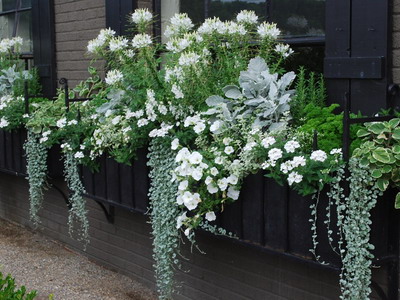
Cleoma, or cleome (Cleome) – a numerous genus of shrubs , annual and perennial herbsgrowing in tropical and temperate latitudes around the world. The culture uses one of the species, which is grown as an ornamental flowering annual .
- Family: cleome.
- Homeland: tropical America and northern Africa.
- Rhizome: powerful tap root.
- Stem: branched, shortly pubescent.
- Leaves: alternate, simple or compound.
- Fruit: single-celled capsule.
- Reproductive capacity: propagated by seeds.
- Illumination: light-requiring.
- Watering: drought-resistant.
- Content temperature: thermophilic, in the middle lane it is grown as an annual.
- Flowering time: from late June until frost.
Cleoma flower: photo and description
Representatives of the genus Cleome are plants with powerful, straight, branched stems from above, pubescent with glandular hairs, sticky to the touch. The leaves are alternate, petiolate, entire, simple or pinnately compound, with elongated linear lobes, at the tops of the stems are always entire and small in size.
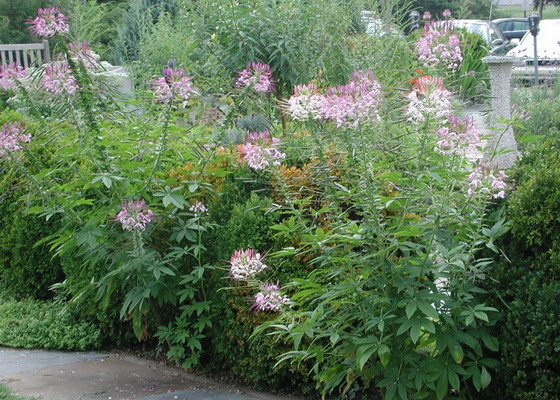
Cleoma flower in the photo
The cleoma flower has a regular four-petal shape, with strongly protruding stamens and a long peduncle, its color can be white, yellow, pink or purple. Collected in multi-flowered apical inflorescences, flowers bloom gradually, starting from the bottom, gradually lengthening the brush. The fruits are a pod-shaped box up to 3 cm in size, single-celled, multi-seeded, with a long peduncle directed to the side. Small black seeds remain viable for up to 3 years.
Although the plant has been known to science for a long time, the taxonomy of the genus caused a lot of controversy and changed several times over time. The culture was attributed to the caper family (Capparaceae), then to the cabbage family (Brassicaceae), and only recently, in 2007, thanks to genetic studies, a separate family of cleomes was isolated, where the genus cleome was placed. According to modern concepts, it includes from 170 to 275 species, the natural habitat of most of which is the tropical and subtropical regions of America and Africa.
Ornamental species and varieties of cleoma plants
Currently, only Hassler’s cleoma (C. Hassleriana) has been introduced into the culture, which, due to the presence of thorns, we usually call “prickly cleoma (C. Spinosa)”.
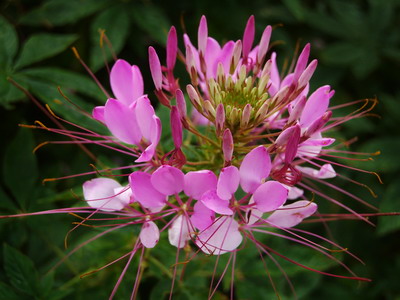
In fact, these are two different, but very similar species that grow in the tropics of South America and differ from each other mainly in the color of the flowers. The real prickly cleoma is used by breeders only for crossing and creating new varieties, however, its name is so widespread in the floricultural literature to designate decorative cleoma that we will continue to use this name in the future. Below are descriptions and photos of prickly cleoma flowers and its common cultivars.
Cleoma prickly
Prickly cleoma (C. Spinosa) is a perennial shrub up to 150 cm high with thick trunks strongly branching in the upper part and lignified below, on which numerous odd-pinnate alternate leaves grow, consisting of 5-7 elongated-lanceolate lobes. There are characteristic short stipules in the form of spikes, which determined the name of the species.

The stems of the plant are erect, sometimes, under the weight of large inflorescences, leaning, which is why it is recommended to support them in flower beds with a support. All parts of the bush are covered with sticky glandular pubescence. In the temperate zone with cold winters, this tropical crop can be grown exclusively as an annual and usually does not exceed 90 – 100 cm in height.
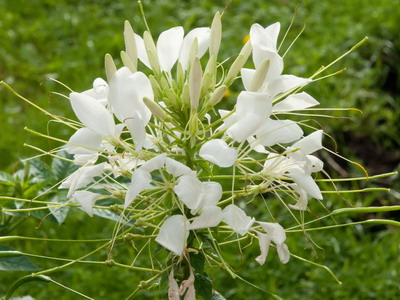
As you can see in the photo, the cleoma flower has a very peculiar shape, the four petals of its corolla are located on one side, and the pistil column and long, thin stamens of a purple or blue hue are on the other side of the flower. This structure makes it look like a spider, which is why in the UK and Germany they call the culture a spider plant or spider (in English – spiderflower, in German – spinenflanze). The color of the corolla petals is mostly pink or pink-purple, modern varieties may also be yellow, white or blue.
Cleome flowers are small, about 2-3 cm in diameter, but very numerous, collected in large, at least 20 cm long, racemose inflorescences that appear in June and stay on the plant until frost. The buds bloom gradually, starting from the bottom of the brush, fading, form elongated, directed to the side, elongated seed pods, which, thanks to the original shape, serve as an additional decoration for the bush, and also do not affect the duration and abundance of flowering.
Cleome has an intense aroma that may not be to everyone’s taste, but is necessary to attract pollinating insects . Many bees flock to his garden, and in the tropics, in their homeland, flowers, thanks to their peculiar smell, pollinate even small species of bats.
Cleoma Cherry Queen with a photo of plants
The plant was introduced into cultivation in 1817; to date, breeders have created a number of varieties and hybrids that differ mainly in flower color.
Among the most common cultivars are:
Pale pink Rozakenigin.

Dark pink large-flowered Giant Pink Kyussen.
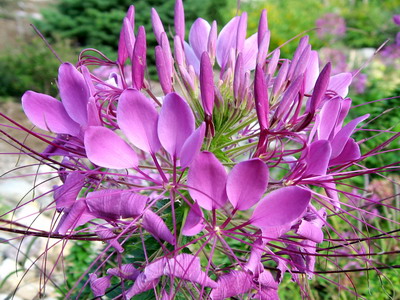
Dwarf Golden Shpakler with yellow petals.
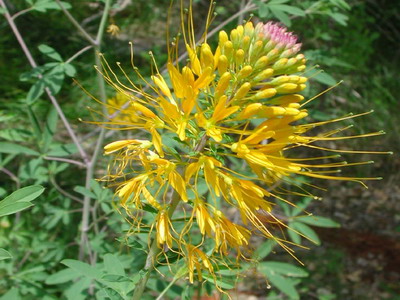
White Helen Campbell.
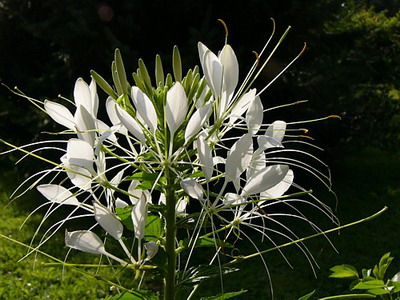
The Queen hybrid series is very popular, among which we highlight cleomas:
Cherry Queen (Cerise Queen) .
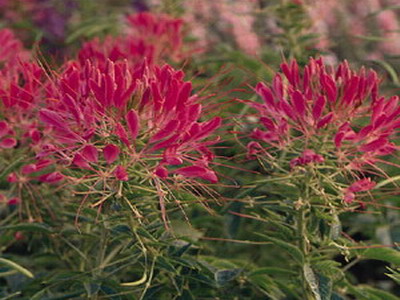
Pink Queen (Pink Queen) .
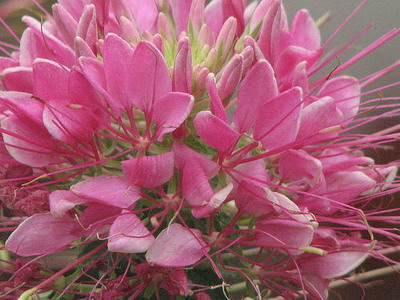
White Queen .
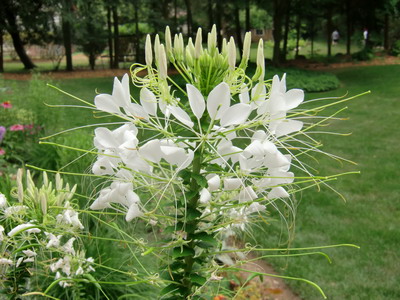
Purple Queen (Violet Queen) with petals colored according to the names.
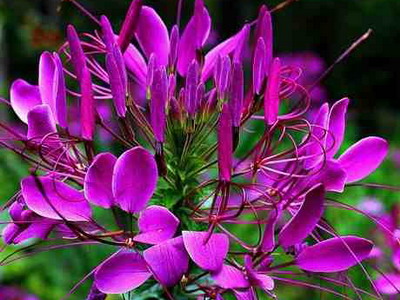
A variety of Colored Fountains is commercially available with plants of a wide variety of colors.
Below are more photos of glue:
Cherry queen.
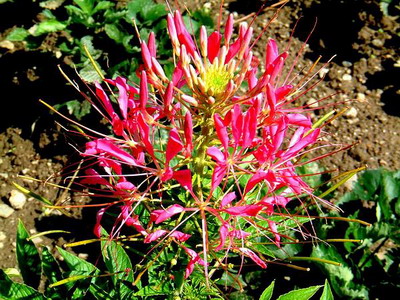
Golden Shpackler.
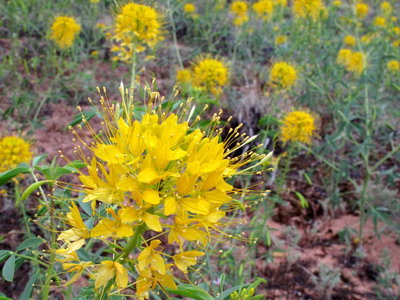
Helen Campbell.
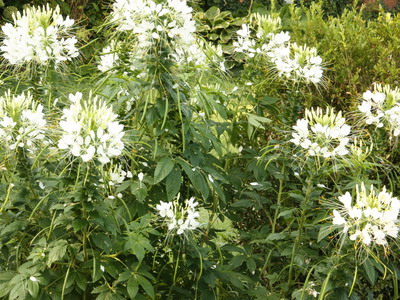
Growing cleoma from seeds
Despite its tropical origin, the culture feels good as an annual in the open ground of central Russia. When grown from seeds, the cleoma develops so intensively that it manages to bloom in a season and form quite viable seeds suitable for propagation. Exotic appearance, large size, decorative inflorescences and leaves are combined in it with lush and long flowering, resistance to pests and diseases, undemanding care.
The plant is easily propagated by seeds that can be sown directly into the ground in spring or before winter, but for earlier flowering it is preferable to grow seedlings. In this case, the seeds are sown in March in prepared containers to a depth of 1-1.5 cm. The composition of the soil mixture should be nutritious, loose and permeable, you can use, for example, a mixture of two parts of humus and garden soil, one part of sand. Landings are covered with glass and placed in a warm, well-lit place, if necessary, provide artificial lighting. Seedlings will appear in 2-3 weeks and will be unfriendly to stimulate seed germination, they can be pre-soaked in any phytohormone . For freshly sprouted cleoma seedlings, care consists in airing and very careful watering, since the sprouts do not respond well to waterlogging of the earthen clod and are much more tolerant of overdrying. Due to the structural features of the root system, only young plants easily tolerate transplantation, so picking is carried out as early as possible and immediately into separate pots. To form a uniform crown, on the windowsill, the seedlings are regularly turned towards the light.
Below are photos of cleoma at various stages of development, from seedlings to seedlings ready for planting:

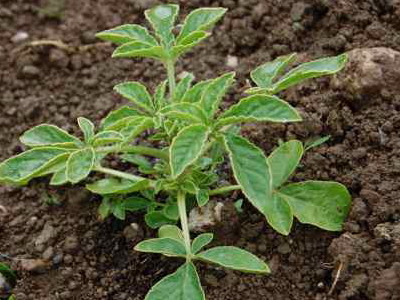
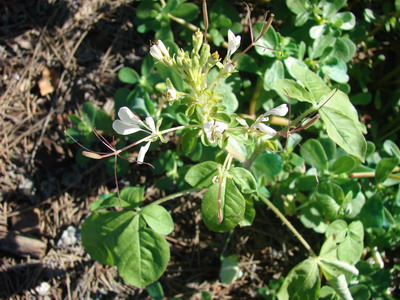
It is transferred to the ground after the establishment of steadily warm weather, usually at the end of May or at the beginning of June, it is placed at a distance of 70-100 cm from each other. Such bushes will bloom in June.
Cleoma planting and plant care
The place for growing cleoma in the garden should be sunny and well protected from the winds. The plant prefers neutral, nutrient-rich soils, with timely feeding it can develop well on poor soils, while it does not tolerate stagnant waterlogging at all. The bushes are drought-resistant, need watering only with a long absence of rain. They do not require frequent feeding, even on poor lands, it is enough to fertilize two weeks after planting in the garden and before flowering. At the beginning of the growing season, young seedlings need weeding.
The culture blooms profusely and for a long time, from the end of June until frost, forms fruits with mature seeds that are easily harvested and can be used for propagation. Gives self-seeding, not very abundant, but quite viable.
The plant is almost not affected by pests and diseases, only in conditions of high humidity it can suffer from fungal diseases (black leg, powdery mildew, gray rot). Control measures – regulation of the water regime and treatment with fungicides .
Due to its original appearance, ease of planting and care, cleoma is increasingly attracting the attention of flower growers, although it is currently rarely found in our gardens. Its tall bushes look great in the background of the garden, surrounded by more compact flowering or even garden crops, can serve as a central element of a flower bed as a tapeworm, are suitable for decorating mesh fences and other structures that do not create shade, and form a spectacular flowering screen when dense group planting. The aroma of flowers attracts bees to the garden, and lush bright inflorescences are good for cutting , as they remain fresh in water for up to 10 days, gradually dissolving numerous buds. Due to their unusual shape and strong stems, they are successfully used to create original floral compositions.
Below is a selection of photos of cleoma flowers used in the garden as various elements of landscape design:

